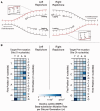Asymmetric Context-Dependent Mutation Patterns Revealed through Mutation-Accumulation Experiments
- PMID: 25750180
- PMCID: PMC4476155
- DOI: 10.1093/molbev/msv055
Asymmetric Context-Dependent Mutation Patterns Revealed through Mutation-Accumulation Experiments
Abstract
Despite the general assumption that site-specific mutation rates are independent of the local sequence context, a growing body of evidence suggests otherwise. To further examine context-dependent patterns of mutation, we amassed 5,645 spontaneous mutations in wild- type (WT) and mismatch-repair deficient (MMR(-)) mutation-accumulation (MA) lines of the gram-positive model organism Bacillus subtilis. We then analyzed>7,500 spontaneous base-substitution mutations across B. subtilis, Escherichia coli, and Mesoplasma florum WT and MMR(-) MA lines, finding a context-dependent mutation pattern that is asymmetric around the origin of replication. Different neighboring nucleotides can alter site-specific mutation rates by as much as 75-fold, with sites neighboring G:C base pairs or dimers involving alternating pyrimidine-purine and purine-pyrimidine nucleotides having significantly elevated mutation rates. The influence of context-dependent mutation on genome architecture is strongest in M. florum, consistent with the reduced efficiency of selection in organisms with low effective population size. If not properly accounted for, the disparities arising from patterns of context-dependent mutation can significantly influence interpretations of positive and purifying selection.
Keywords: Bacillus subtilis; context-dependent mutation; mismatch repair; mutation rate.
Published by Oxford University Press on behalf of the Society for Molecular Biology and Evolution 2015. This work is written by US Government employees and is in the public domain in the US.
Figures




References
Publication types
MeSH terms
Substances
Grants and funding
LinkOut - more resources
Full Text Sources
Other Literature Sources

